2020年整理国际经济学国际贸易试题山东大学经济学院.doc
- 格式:doc
- 大小:1.41 MB
- 文档页数:12
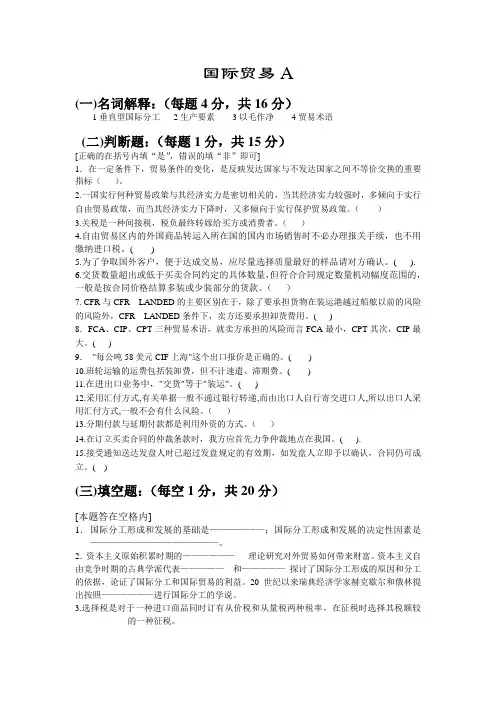
国际贸易A(一)名词解释:(每题4分,共16分)1垂直型国际分工2生产要素3以毛作净4贸易术语(二)判断题:(每题1分,共15分)[正确的在括号内填“是”,错误的填“非”即可]1.在一定条件下,贸易条件的变化,是反映发达国家与不发达国家之间不等价交换的重要指标()。
2.一国实行何种贸易政策与其经济实力是密切相关的,当其经济实力较强时,多倾向于实行自由贸易政策,而当其经济实力下降时,又多倾向于实行保护贸易政策。
()3.关税是一种间接税,税负最终转嫁给买方或消费者。
()4.自由贸易区内的外国商品转运入所在国的国内市场销售时不必办理报关手续,也不用缴纳进口税。
( )5.为了争取国外客户,便于达成交易,应尽量选择质量最好的样品请对方确认。
( ).6.交货数量超出或低于买卖合同约定的具体数量,但符合合同规定数量机动幅度范围的,一般是按合同价格结算多装或少装部分的货款。
()7. CFR与CFR LANDED的主要区别在于,除了要承担货物在装运港越过船舷以前的风险的风险外,CFR LANDED条件下,卖方还要承担卸货费用。
( )8.FCA、CIP、CPT三种贸易术语,就卖方承担的风险而言FCA最小,CPT其次,CIP最大。
( )9."每公吨58美元CIF上海"这个出口报价是正确的。
( )10.班轮运输的运费包括装卸费,但不计速遣、滞期费。
( )11.在进出口业务中,"交货"等于"装运"。
( )12.采用汇付方式,有关单据一般不通过银行转递,而由出口人自行寄交进口人,所以出口人采用汇付方式,一般不会有什么风险。
()13.分期付款与延期付款都是利用外资的方式。
()14.在订立买卖合同的仲裁条款时,我方应首先力争仲裁地点在我国。
( ).15.接受通知送达发盘人时已超过发盘规定的有效期,如发盘人立即予以确认,合同仍可成立。
( )(三)填空题:(每空1分,共20分)[本题答在空格内]1.国际分工形成和发展的基础是——————;国际分工形成和发展的决定性因素是——————————————。
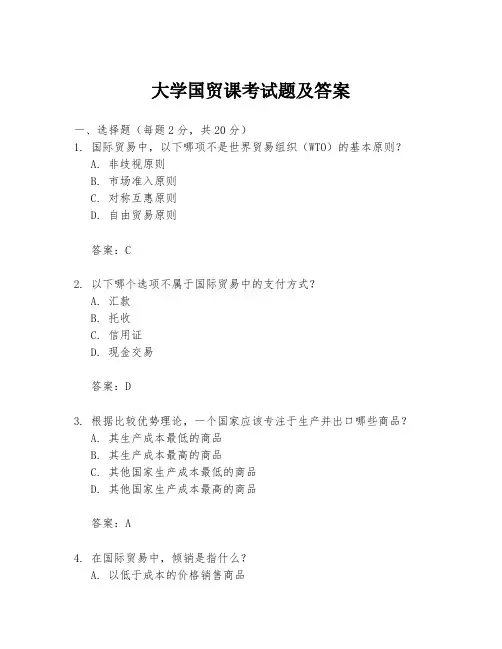
大学国贸课考试题及答案一、选择题(每题2分,共20分)1. 国际贸易中,以下哪项不是世界贸易组织(WTO)的基本原则?A. 非歧视原则B. 市场准入原则C. 对称互惠原则D. 自由贸易原则答案:C2. 以下哪个选项不属于国际贸易中的支付方式?A. 汇款B. 托收C. 信用证D. 现金交易答案:D3. 根据比较优势理论,一个国家应该专注于生产并出口哪些商品?A. 其生产成本最低的商品B. 其生产成本最高的商品C. 其他国家生产成本最低的商品D. 其他国家生产成本最高的商品答案:A4. 在国际贸易中,倾销是指什么?A. 以低于成本的价格销售商品B. 以高于成本的价格销售商品C. 以低于市场价格销售商品D. 以高于市场价格销售商品答案:A5. 以下哪个不是国际货币基金组织(IMF)的主要职能?A. 监督全球经济和金融稳定B. 提供技术援助和培训C. 促进国际贸易平衡D. 提供资金支持以帮助成员国应对经济困难答案:C6. 保护主义在国际贸易中通常指的是什么?A. 保护本国产业免受外国竞争A. 保护外国产业免受本国竞争B. 促进国际贸易自由化C. 限制本国产业的发展答案:A7. 以下哪个不是国际货物运输中的主要风险?A. 货物损坏B. 货物丢失C. 运输成本上升D. 运输时间延误答案:C8. 国际贸易中的“最惠国待遇”是指什么?A. 给予所有贸易伙伴相同的关税优惠B. 给予某些贸易伙伴特殊的关税优惠C. 只给予特定国家关税优惠D. 不给予任何国家关税优惠答案:A9. 以下哪个因素通常不会影响汇率的变动?A. 经济政策B. 政治稳定性C. 文化差异D. 国际贸易平衡答案:C10. 在国际贸易中,哪项措施不属于贸易壁垒?A. 关税B. 配额C. 出口补贴D. 产品标准答案:C二、简答题(每题10分,共30分)1. 简述绝对优势理论的基本内容及其在国际贸易中的应用。
答案:绝对优势理论由亚当·斯密提出,主张一个国家应该生产并出口那些它能够以较低成本生产的商品,同时进口那些它生产成本较高的商品。
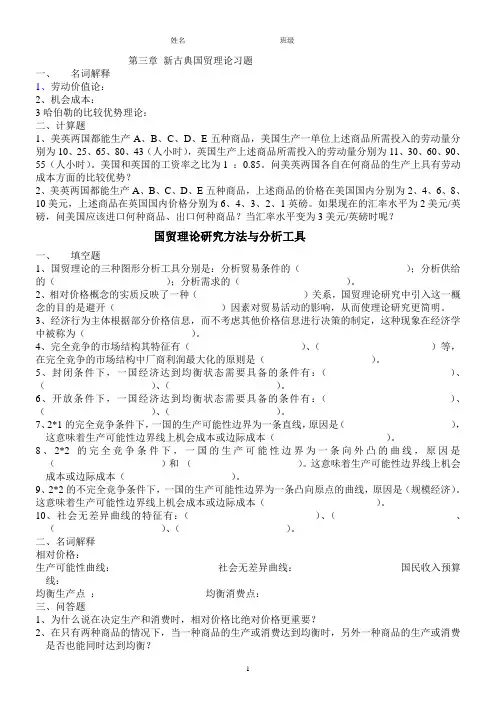
第三章新古典国贸理论习题一、名词解释1、劳动价值论:2、机会成本:3哈伯勒的比较优势理论:二、计算题1、美英两国都能生产A、B、C、D、E五种商品,美国生产一单位上述商品所需投入的劳动量分别为10、25、65、80、43(人小时),英国生产上述商品所需投入的劳动量分别为11、30、60、90、55(人小时)。
美国和英国的工资率之比为1 :0.85。
问美英两国各自在何商品的生产上具有劳动成本方面的比较优势?2、美英两国都能生产A、B、C、D、E五种商品,上述商品的价格在美国国内分别为2、4、6、8、10美元,上述商品在英国国内价格分别为6、4、3、2、1英磅。
如果现在的汇率水平为2美元/英磅,问美国应该进口何种商品、出口何种商品?当汇率水平变为3美元/英磅时呢?国贸理论研究方法与分析工具一、填空题1、国贸理论的三种图形分析工具分别是:分析贸易条件的();分析供给的();分析需求的()。
2、相对价格概念的实质反映了一种()关系,国贸理论研究中引入这一概念的目的是避开()因素对贸易活动的影响,从而使理论研究更简明。
3、经济行为主体根据部分价格信息,而不考虑其他价格信息进行决策的制定,这种现象在经济学中被称为()。
4、完全竞争的市场结构其特征有()、()等,在完全竞争的市场结构中厂商利润最大化的原则是()。
5、封闭条件下,一国经济达到均衡状态需要具备的条件有:()、()、()。
6、开放条件下,一国经济达到均衡状态需要具备的条件有:()、()、()。
7、2*1的完全竞争条件下,一国的生产可能性边界为一条直线,原因是(),这意味着生产可能性边界线上机会成本或边际成本()。
8、2*2的完全竞争条件下,一国的生产可能性边界为一条向外凸的曲线,原因是()和()。
这意味着生产可能性边界线上机会成本或边际成本()。
9、2*2的不完全竞争条件下,一国的生产可能性边界为一条凸向原点的曲线,原因是(规模经济)。
这意味着生产可能性边界线上机会成本或边际成本()。
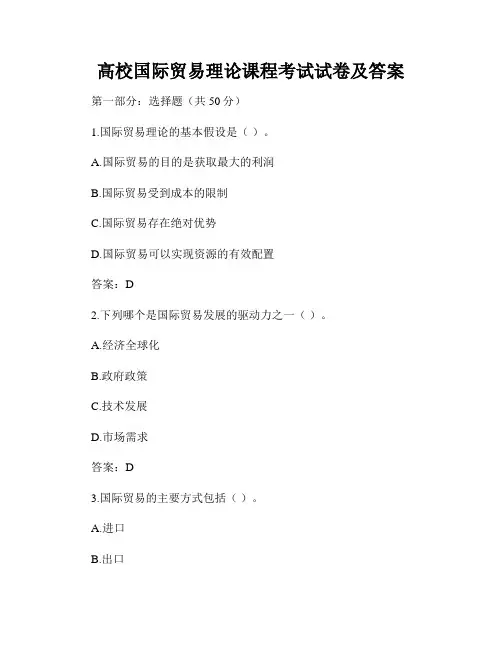
高校国际贸易理论课程考试试卷及答案第一部分:选择题(共50分)1.国际贸易理论的基本假设是()。
A.国际贸易的目的是获取最大的利润B.国际贸易受到成本的限制C.国际贸易存在绝对优势D.国际贸易可以实现资源的有效配置答案:D2.下列哪个是国际贸易发展的驱动力之一()。
A.经济全球化B.政府政策C.技术发展D.市场需求答案:D3.国际贸易的主要方式包括()。
A.进口B.出口C.外包D.合资答案:A、B4.贸易保护主义的措施包括()。
A.关税B.配额限制C.补贴D.进口限制答案:A、B、C、D5.自由贸易区的特点是()。
A.减少贸易壁垒B.自由的货物流通C.成员国保留关税政策D.共同的外部关税政策答案:A、B6.典型的国际贸易理论包括()。
A.比较优势理论B.绝对优势理论C.国际产品周期理论D.新贸易理论答案:A、B、C、D7.国际贸易的风险主要包括()。
A.汇率风险B.政治风险C.市场风险D.物流风险答案:A、B、C、D8.国际贸易中的价格歧视指的是()。
A.同一产品在不同国家的价格不同B.不同产品在同一国家的价格不同C.同一产品在同一国家的价格不同D.不同产品在不同国家的价格不同答案:A9.利用国际分工原理,各国通过贸易进行资源配置,可以实现的效果包括()。
A.经济效益最大化B.产业创新促进C.提高生产效率D.推动经济发展答案:A、B、C、D10. WTO(世界贸易组织)的主要功能包括()。
A.促进贸易自由化B.解决贸易争端C.制定贸易规则D.监督成员国的贸易政策答案:A、B、C、D第二部分:简答题(共30分)1.简述比较优势理论的基本内容及假设。
答案:比较优势理论是由亚当·斯密提出的,其基本内容是通过比较两国在生产某种商品时的机会成本,来判断各自的优势所在。
假设包括:1)资源有限性:每个国家的资源有限,不能同时生产所有产品;2)生产效率差异:各国的生产力和生产技术不同;3)劳动可转移性:各国劳动力可以自由转移;4)无生产外部性:生产一种商品对其他商品的生产没有影响。
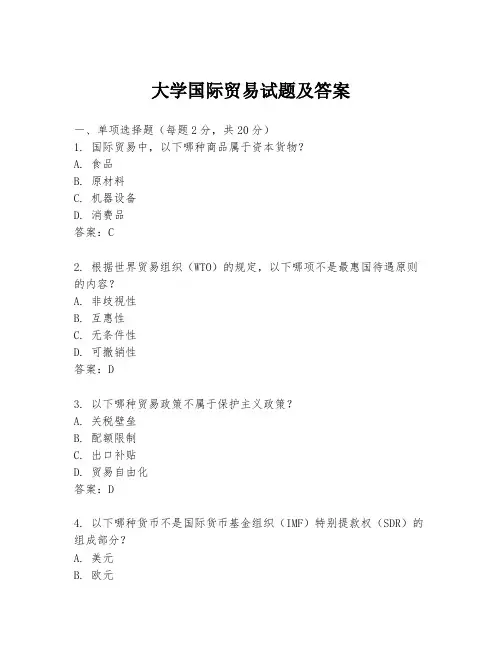
大学国际贸易试题及答案一、单项选择题(每题2分,共20分)1. 国际贸易中,以下哪种商品属于资本货物?A. 食品B. 原材料C. 机器设备D. 消费品答案:C2. 根据世界贸易组织(WTO)的规定,以下哪项不是最惠国待遇原则的内容?A. 非歧视性B. 互惠性C. 无条件性D. 可撤销性答案:D3. 以下哪种贸易政策不属于保护主义政策?A. 关税壁垒B. 配额限制C. 出口补贴D. 贸易自由化答案:D4. 以下哪种货币不是国际货币基金组织(IMF)特别提款权(SDR)的组成部分?A. 美元B. 欧元D. 印度卢比答案:D5. 国际贸易中,以下哪种支付方式不属于信用证支付?A. 即期信用证B. 远期信用证C. 托收D. 汇票答案:C6. 根据国际货币基金组织(IMF)的定义,以下哪项不是国际收支平衡表的组成部分?A. 经常账户B. 资本账户C. 金融账户D. 储备资产答案:B7. 以下哪种贸易术语不属于国际贸易术语解释通则(Incoterms)?A. EXWB. FOBC. CIFD. DDP答案:D8. 以下哪种国际市场进入方式不属于直接投资?A. 合资企业B. 独资企业C. 特许经营D. 出口9. 以下哪种贸易政策不属于自由贸易政策?A. 零关税B. 贸易配额C. 贸易自由化D. 贸易便利化答案:B10. 以下哪种因素不属于影响国际竞争力的因素?A. 技术创新B. 劳动力成本C. 政府干预D. 消费者偏好答案:D二、多项选择题(每题3分,共15分)1. 以下哪些因素会影响一个国家的贸易平衡?A. 出口量B. 进口量C. 国内生产总值D. 汇率答案:A, B, D2. 以下哪些属于国际货币基金组织(IMF)的主要职能?A. 监督成员国的经济政策B. 提供短期资金援助C. 促进国际货币合作D. 制定国际贸易规则答案:A, B, C3. 以下哪些属于国际贸易中的风险?A. 信用风险B. 汇率风险C. 政治风险D. 市场风险答案:A, B, C, D4. 以下哪些属于国际贸易中的非关税壁垒?A. 配额限制B. 进口许可证C. 技术标准D. 反倾销税答案:A, B, C, D5. 以下哪些属于国际直接投资的形式?A. 绿地投资B. 跨国并购C. 合资企业D. 特许经营答案:A, B, C, D三、简答题(每题5分,共20分)1. 简述国际贸易中自由贸易与保护主义的区别。
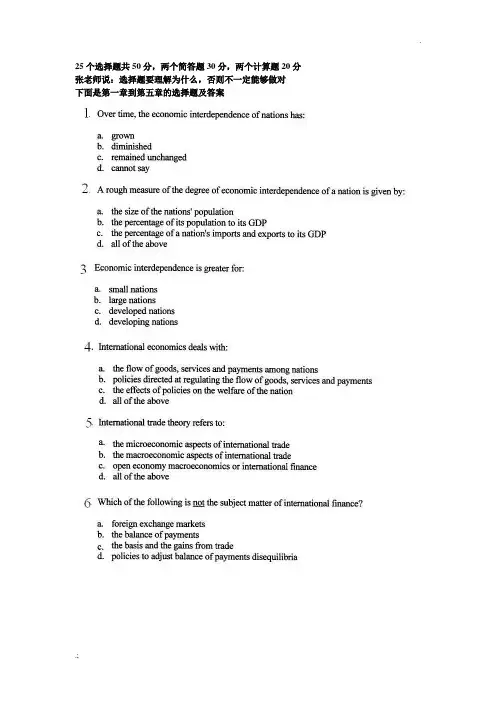
25个选择题共50分,两个简答题30分,两个计算题20分张老师说:选择题要理解为什么,否则不一定能够做对下面是第一章到第五章的选择题及答案余下答案:acadaccacbInterdependence: 互相依赖international:. 国际的microeconomic: 微观经济interregional:地区间的Choice questions1 Ricardo explained the law of comparative advantage on the basis of( A)A the labor theory of valueB the opportunity cost theoryC the law of diminishing returns:边际报酬递减定律D all of the above2. If with one hour of labor time nation A can produce either 3X or 3Y while nation B can produce either 1X or 3Y (and labor is the only input投入), the range of mutually 互相的beneficial trade between nation A and B is: (C )A. 3Y<3X<5YB. 5Y<3X<9YC. 3Y<3X<9YD. 1Y<3X<3Y3. The commodity商品in which the nation has the smallest absolute disadvantage is thecommodity of its (D ).A. absolute disadvantageB. absolute advantageC. comparative disadvantageD. comparative advantage4. If in a two-nation (A and B), two-commodity (X and Y) world, it is established that nation A has a comparative advantage in commodity X, then nation B must have: (D )A an absolute advantage in commodity YB an absolute disadvantage in commodity YC a comparative disadvantage in commodity YD a comparative advantage in commodity Y5. If domestically 国内的3X=3Y in nation A, while 1X=1Y domestically in nation B:(D )A there will be no trade between the two nationsB the relative price of X is the same in both nationsC the relative price of Y is the same in both nationsD all of the above6. An increase in the dollar price of a foreign currency 货币usually ( B)A benefits U.S. importers进口商B benefits U.S. Exporters 出口商C benefits both U.S. importers and U.S. exportersD harms both U.S. importers and U.S. exporters7. The Mercantilists 重商主义者did not advocate 提倡( A)A free tradeB stimulating the nation’s exports stimulate刺激C restricting 限制the nation’s importsD the accumulation积聚of gold by the nationSlope 倾斜stepwise 逐步地equilibrium relative commodity均衡相对商品intersection交叉点余下答案:BACDbd1. Which of the following statements is true with respect to the MRS of X for Y? ( D)A. It is given by the absolute slope斜率of the indifference curve 无差异曲线B. declines下降as the nation moves down an indifference curveC. rises as the nation moves up an indifference curveD. all of the above2 The marginal rate of transformation边际转换率(MRT)of X for Y refers to ( D)A the amount of Y that a nation must give up to produce each additional unit单位of XB the opportunity cost of XC the absolute slope of the production frontier生产可能性边界at the point of productionD all of the above3 The marginal rate of substitution边际替换率(MRS) of X for Y in consumption消费refers to the ( B)A amount of X that a nation must give up for one extra unit of Y and still remain on the same indifference curveB amount of Y that a nation must give up for one extra unit of X and still remain on the same indifference curveC amount of X that a nation must give up for one extra unit of Y to reach a higher indifference curveD amount of Y that a nation must give up for one extra unit of X to reach a higher indifference curve4. Which of the following is not a reason for increasing opportunity costs? ( A)A. technology differs among nationsB. factors of production are not homogenous同质的C. factors of production are not used in the same fixed proportion固定比例in the production of all commoditiesD. For the nation to produce more of a commodity, it must use resources that are less and less suited适合in the production of the commodity5. Export prices出口价格must rise for a nation to increase its exports because the nation: ( D)A incurs招致increasing opportunity costs in export productionB faces decreasing减少opportunity costs in producing import substitutes. 替代品C faces decreasing marginal rate of substitution in consumptionD all of the above6. In the trade between a small and a large nation (B ).A. the large nation is likely to receive all of the gains from tradeB. the small nation is likely to receive all of the gains from tradeC. the gains from trade are likely to equally sharedD. we cannot say7 Commodity indifference curves (D )A are negatively slopedB are convex凸的to the origin原点C should not cross交叉D all of the above8. Nation 1’s share份额of the gains from trade will be greater: (B )A. the greater is nation 1’s demand for nation 2’s exportsB. the closer Px/Py with trade settles贸易落定to nation 2’s pretrade Px/PyC. the weaker is nation 2’s demand for nation 1’s exportsD. the closer Px/Py with trade settles to nation 1’s pretrade Px/Pyconcave凹的intersect 相交application 应用equilibrium均衡compensation principle补偿原则isolation孤立inside在…之内tangent切线internal. 内部的exceed超过specialize专门化mutually互相地taste偏好余下答案:cdcacddddd1. If a nation does not affect world prices by its trading, its offer curve: ( a)A. is a straight lineB. bulges凸出toward the axis轴measuring衡量the import commodityC. intersects相交the straight-line直线segment部分of the world’s offer curveD. intersects the positively-sloped portion积极倾斜的部分of the world’s offer curve2. Which of the following statements regarding partial equilibrium analysis局部均衡分析is false? (c )A. it relies on traditional demand and supply curvesB. it isolates for study one marketC. it can be used to determine the equilibrium relative commodity price均衡相对商品价格but not the equilibrium quantity均衡产量with tradeD. it does not take into considerations the interactions相互作用between different markets3. If the nation’s tastes for its import commodity increases (d )A. the nation’s offer curve rotates旋转toward the axis measuring its import commodityB. the partner’s offer curve rotates toward the axis measuring its import commodityC. the partner’s offer curve rotates toward the axis measuring its export commodityD. the nation’s offer curve rotates toward the axis measuring its export commodity4. The offer curve of a nation bulges凸出toward the axis measuring the nation’s ( a)A. import commodityB. export commodityC. export or import commodityD. nontraded commodity5. The offer curve of a nation shows: (d )A. the supply of a nation’s importsB. the demand for a nation’s exportsC. the trade partner’s demand for imports and supply of exportsD. the nation’s demand for imports and supply of exports6. If the terms of trade贸易条件of a nation are 1.5 in a two-nation world, those of the trade partner are: ( b)A. 3/4B. 2/3C. 3/2D. 4/37. A deterioration恶化of a nation’s terms of trade causes the nation’s welfare to: (d )A. deteriorateB. improveC. remain unchangedD. any of the aboveapproximation近似sought寻找V olume量余下答案:dcdddaba1. Which is not an assumption假设of the H-O model? ( c)A. the same the technology in both nationsB. constant returns to scale规模报酬不变C. complete specialization完全专业化D. equal tastes相同偏好in both nations2. The Leontief paradox里昂惕夫悖论refers to the empirical finding实证发现that U.S.:(a )A. import substitutes are more K-intensive than exportsB. imports are more K-intensive than exportsC. exports are more L-intensive than importsD. exports are more K-intensive than import substitutes3. In the H-O model, international trade is based mostly on a difference in: (b )A. technologyB. factor endowments禀赋C. economies of scale规模经济D. tastes4. The H-O model extends延伸the classical trade model by: (c)A. explaining the basis for comparative advantageB. examining检查the effect of trade on factor pricesC. both A and BD. neither A nor B5. A difference in relative commodity prices between two nations can be based upon a difference in (d )A. factor endowmentsB. technologyC. tastesD. all of the above6. For factor reversal逆转to occur, two commodities must be produced with: (a )A. sufficiently充分地different elasticity of substitution替代弹性of factorsB. the same K/L ratio比率C. technologically-fixed factor proportions比例D. equal elasticity of substitution of factorsintensive集中的reject驳回,排斥await 等候余下答案:acbdcaddc简答题:每题最好都画图1.贸易理论:US和UK两国的W和C互换(见书),计算两国贸易所得2.画图说明一国两种产品的最优组合(无差异曲线与生产可能性曲线相交的切点)3.画图说明即使生产可能性曲线一样,无差异曲线不同,两国也能发生贸易4.求两国的提供曲线以及均衡贸易量和均衡产品价格5.Draw the offer curves for Nation 1 and Nation 2, showing that Nation 2 is a small nationthat trades at the pretrade-relative commodity prices in Nation 1. How are the gains fromtrade distributed between the two nations? Why?6.H—O—S模型,H—O模型7.里昂休斯悖论及解释6.幼稚产业观点7.说明产品周期8.Table 9——1 配额和关税的区别(因书上文字过多,就不一一写答案了)计算:1.题给两国的供给,需求曲线,求没有贸易时孤立均衡点2.给出供给,需求曲线的方程,计算关税,消费者损失,生产者剩余增加额(配额)3.第六章计算题第三题。
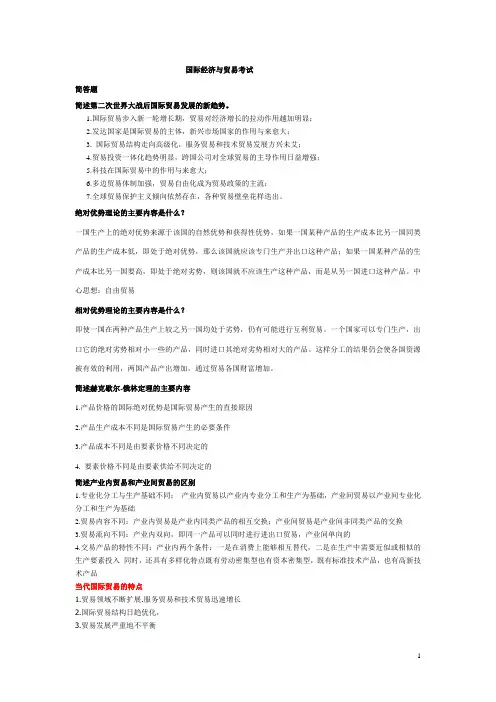
国际经济与贸易考试简答题简述第二次世界大战后国际贸易发展的新趋势。
1.国际贸易步入新一轮增长期,贸易对经济增长的拉动作用越加明显;2.发达国家是国际贸易的主体,新兴市场国家的作用与来愈大;3. 国际贸易结构走向高级化,服务贸易和技术贸易发展方兴未艾;4.贸易投资一体化趋势明显,跨国公司对全球贸易的主导作用日益增强;5.科技在国际贸易中的作用与来愈大;6.多边贸易体制加强,贸易自由化成为贸易政策的主流;7.全球贸易保护主义倾向依然存在,各种贸易壁垒花样迭出。
绝对优势理论的主要内容是什么?一国生产上的绝对优势来源于该国的自然优势和获得性优势,如果一国某种产品的生产成本比另一国同类产品的生产成本低,即处于绝对优势,那么该国就应该专门生产并出口这种产品;如果一国某种产品的生产成本比另一国要高,即处于绝对劣势,则该国就不应该生产这种产品,而是从另一国进口这种产品。
中心思想:自由贸易相对优势理论的主要内容是什么?即使一国在两种产品生产上较之另一国均处于劣势,仍有可能进行互利贸易。
一个国家可以专门生产,出口它的绝对劣势相对小一些的产品,同时进口其绝对劣势相对大的产品。
这样分工的结果仍会使各国资源被有效的利用,两国产品产出增加,通过贸易各国财富增加。
简述赫克歇尔-俄林定理的主要内容1.产品价格的国际绝对优势是国际贸易产生的直接原因2.产品生产成本不同是国际贸易产生的必要条件3.产品成本不同是由要素价格不同决定的4. 要素价格不同是由要素供给不同决定的简述产业内贸易和产业间贸易的区别1.专业化分工与生产基础不同:产业内贸易以产业内专业分工和生产为基础,产业间贸易以产业间专业化分工和生产为基础2.贸易内容不同:产业内贸易是产业内同类产品的相互交换;产业间贸易是产业间非同类产品的交换3.贸易流向不同:产业内双向,即同一产品可以同时进行进出口贸易,产业间单向的4.交易产品的特性不同:产业内两个条件:一是在消费上能够相互替代,二是在生产中需要近似或相似的生产要素投入同时,还具有多样化特点既有劳动密集型也有资本密集型,既有标准技术产品,也有高新技术产品当代国际贸易的特点1.贸易领域不断扩展.服务贸易和技术贸易迅速增长2.国际贸易结构日趋优化,3.贸易发展严重地不平衡4.商品贸易增长速度加快5.国际贸易集团化趋势不断加强6.国际贸易方式单一型向多元化发展7.国际贸易向无纸化方向发展8.国际贸易协调机制趋于规范简述李斯特保护幼稚工业理论的内容1.结合具体国情选择贸易政策2.发展生产力是制定贸易政策的出发点3.通过国家干预经济保护幼稚工业简述李斯特保护幼稚工业理论的政策主张1.保护目的促进和保护国内生产力发展2.保护对象发展初期阶段又面临外国强大竞争的有发展前途的工业3.保护手段建立起保护性且有条件有时间限制的关税制度逐步提高关税,国家随着工业发展水平的提高逐步降低关税4.保护程度不同行业的保护程度应不同,奢侈消费品征收很低关税,征税过高刺激走私;对国内不能生产的各种复杂机器的进口应当免税或者征收很低关税,过分限制会影响国内工业的发展速度。
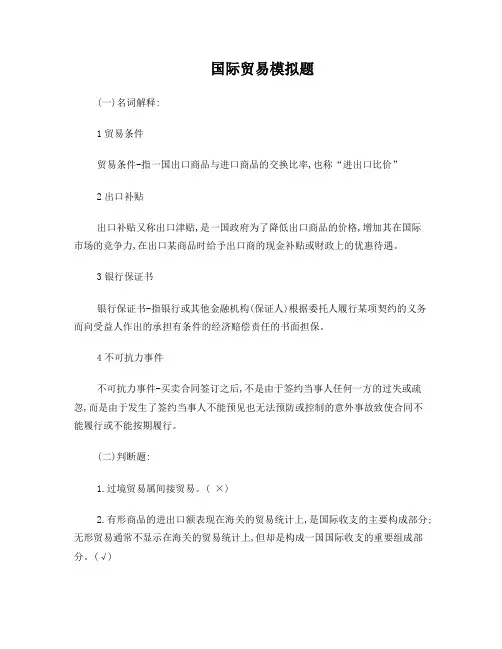
国际贸易模拟题(一)名词解释:1贸易条件贸易条件-指一国出口商品与进口商品的交换比率,也称“进出口比价”2出口补贴出口补贴又称出口津贴,是一国政府为了降低出口商品的价格,增加其在国际市场的竞争力,在出口某商品时给予出口商的现金补贴或财政上的优惠待遇。
3银行保证书银行保证书-指银行或其他金融机构(保证人)根据委托人履行某项契约的义务而向受益人作出的承担有条件的经济赔偿责任的书面担保。
4不可抗力事件不可抗力事件-买卖合同签订之后,不是由于签约当事人任何一方的过失或疏忽,而是由于发生了签约当事人不能预见也无法预防或控制的意外事故致使合同不能履行或不能按期履行。
(二)判断题:1.过境贸易属间接贸易。
( ×)2.有形商品的进出口额表现在海关的贸易统计上,是国际收支的主要构成部分;无形贸易通常不显示在海关的贸易统计上,但却是构成一国国际收支的重要组成部分。
(√)3.差价税是根据商品进口价格高于内部价格的差额来征收。
( ×)4.自由贸易区内的外国商品转运入所在国的国内市场销售时不必办理报关手续,也不用缴纳进口税。
( ×)5.接国外买方来样后,我方根据来样复制相同品质的样品,寄交买方确认,该复制的样品称为复样。
( ×)6.FCA、CIP、CPT三种贸易术语,就卖方承担的风险而言FCA最小,CPT其次,CIP最大。
( ×)7.FOB UNDER TACKLE是指卖方负责把货物装进船舱,脱离吊钩。
( ×)8.班轮运输的运费包括装卸费,但不计速遣、滞期费。
( √)9.按收货人的抬头分类,提单主要有记名提单(straight B/L)和指示提单(Order B/L),我出口业务中常用的是指示提单。
( √)10.我方按CFR贸易术语进口一批货物,在国内投保了一切险。
货物在装运港越过船舷以前发生损失,因该损失属于仓至仓条款规定的保险公司责任起迄范围,故保险公司应予赔偿。
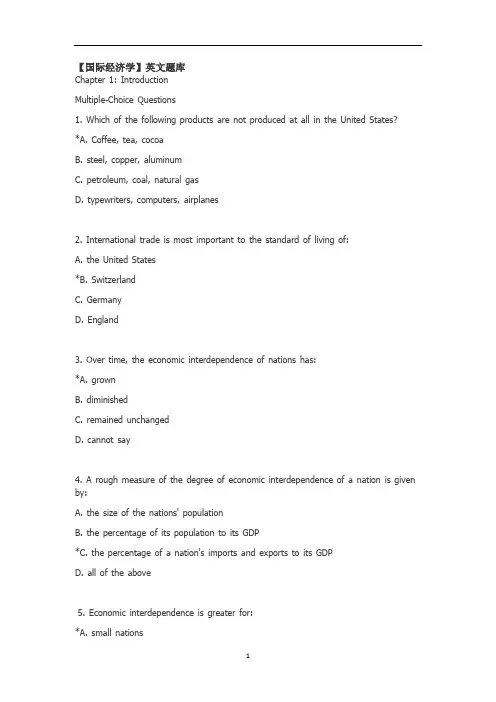
【国际经济学】英文题库Chapter 1: IntroductionMultiple-Choice Questions1. Which of the following products are not produced at all in the United States?*A. Coffee, tea, cocoaB. steel, copper, aluminumC. petroleum, coal, natural gasD. typewriters, computers, airplanes2. International trade is most important to the standard of living of:A. the United States*B. SwitzerlandC. GermanyD. England3. Over time, the economic interdependence of nations has:*A. grownB. diminishedC. remained unchangedD. cannot say4. A rough measure of the degree of economic interdependence of a nation is given by:A. the size of the nations' populationB. the percentage of its population to its GDP*C. the percentage of a nation's imports and exports to its GDPD. all of the above5. Economic interdependence is greater for:*A. small nationsB. large nationsC. developed nationsD. developing nations6. The gravity model of international trade predicts that trade between two nations is largerA. the larger the two nationsB. the closer the nationsC. the more open are the two nations*D. all of the above7. International economics deals with:A. the flow of goods, services, and payments among nationsB. policies directed at regulating the flow of goods, services, and paymentsC. the effects of policies on the welfare of the nation*D. all of the above8. International trade theory refers to:*A. the microeconomic aspects of international tradeB. the macroeconomic aspects of international tradeC. open economy macroeconomics or international financeD. all of the above9. Which of the following is not the subject matter of international finance?A. foreign exchange marketsB. the balance of payments*C. the basis and the gains from tradeD. policies to adjust balance of payments disequilibria10. Economic theory:A. seeks to explain economic eventsB. seeks to predict economic eventsC. abstracts from the many detail that surrounds an economic event*D. all of the above11. Which of the following is not an assumption generally made in the study of inter national economics?A. two nationsB. two commodities*C. perfect international mobility of factorsD. two factors of production12. In the study of international economics:A. international trade policies are examined before the bases for tradeB. adjustment policies are discussed before the balance of paymentsC. the case of many nations is discussed before the two-nations case*D. none of the above13. International trade is similar to interregional trade in that both must overcome: *A. distance and spaceB. trade restrictionsC. differences in currenciesD. differences in monetary systems14. The opening or expansion of international trade usually affects all members of so ciety:A. positivelyB. negatively*C. most positively but some negativelyD. most negatively but some positively15. An increase in the dollar price of a foreign currency usually:A. benefit U.S. importers*B. benefits U.S. exportersC. benefit both U.S. importers and U.S. exportersD. harms both U.S. importers and U.S. exporters16. Which of the following statements with regard to international economics is true?A. It is a relatively new field*B. it is a relatively old fieldC. most of its contributors were not economistsD. none of the above思考题:1.为什么学习国际经济学非常重要?2.列举体现当前国际经济学问题的一些重要事件,它们为什么重要?3.当今世界面临的最重要的国家经济问题是什么?全球化的利弊各是什么?Chapter 2: The Law of Comparative AdvantageMultiple-Choice Questions1. The Mercantilists did not advocate:*A.free tradeB. stimulating the nation's exportsC. restricting the nations' importsD. the accumulation of gold by the nation2. According to Adam Smith, international trade was based on:*A. absolute advantageB. comparative advantageC. both absolute and comparative advantageD. neither absolute nor comparative advantage3. What proportion of international trade is based on absolute advantage?A. AllB. most*C. someD. none4. The commodity in which the nation has the smallest absolute disadvantage is the commodity of its:A. absolute disadvantageB. absolute advantageC. comparative disadvantage*D. comparative advantage5. If in a two-nation (A and B), two-commodity (X and Y) world, it is established tha t nation A has a comparative advantage in commodity X, then nation B must have:A. an absolute advantage in commodity YB. an absolute disadvantage in commodity YC. a comparative disadvantage in commodity Y*D. a comparative advantage in commodity Y6. If with one hour of labor time nation A can produce either 3X or 3Y while nationB can produce either 1X or 3Y (and labor is the only input):A. nation A has a comparative disadvantage in commodity XB. nation B has a comparative disadvantage in commodity Y*C. nation A has a comparative advantage in commodity XD. nation A has a comparative advantage in neither commodity7. With reference to the statement in Question 6:A. Px/Py=1 in nation AB. Px/Py=3 in nation BC. Py/Px=1/3 in nation B*D. all of the above8. With reference to the statement in Question 6, if 3X is exchanged for 3Y:A. nation A gains 2X*B. nation B gains 6YC. nation A gains 3YD. nation B gains 3Y9. With reference to the statement of Question 6, the range of mutually beneficial tra de between nation A and B is:A. 3Y < 3X < 5YB. 5Y < 3X < 9Y*C. 3Y < 3X < 9YD. 1Y < 3X < 3Y10. If domestically 3X=3Y in nation A, while 1X=1Y domestically in nation B:A. there will be no trade between the two nationsB. the relative price of X is the same in both nationsC. the relative price of Y is the same in both nations*D. all of the above11. Ricardo explained the law of comparative advantage on the basis of:*A. the labor theory of valueB. the opportunity cost theoryC. the law of diminishing returnsD. all of the above12. Which of the following statements is true?A. The combined demand for each commodity by the two nations is negatively slope dB. the combined supply for each commodity by the two nations is rising stepwiseC. the equilibrium relative commodity price for each commodity with trade is giv en by the intersection of the demand and supply of each commodity by the two nati ons*D. all of the above13. A difference in relative commodity prices between two nations can be based upo n a difference in:A. factor endowmentsB. technologyC. tastes*D. all of the above14. In the trade between a small and a large nation:A. the large nation is likely to receive all of the gains from trade*B. the small nation is likely to receive all of the gains from tradeC. the gains from trade are likely to be equally sharedD. we cannot say15. The Ricardian trade model has been empirically*A. verifiedB. rejectedC. not testedD. tested but the results were inconclusive思考题:比较优势原理所带来的贸易所得是从何而来的?贸易利益又是如何分配的?现实世界中比较优势是如何度量的?你认为目前中国具有比较优势的商品有哪些?这意味着什么?比较优势会不会发生变化?什么样的原因可能会导致其变化?经济学家是如何验证比较优势原理的?Chapter 3: The Standard Theory of International TradeMultiple-Choice Questions1. A production frontier that is concave from the origin indicates that the nation incur s increasing opportunity costs in the production of:A. commodity X onlyB. commodity Y only*C. both commoditiesD. neither commodity2. The marginal rate of transformation (MRT) of X for Y refers to:A. the amount of Y that a nation must give up to produce each additional unit of XB. the opportunity cost of XC. the absolute slope of the production frontier at the point of production*D. all of the above3. Which of the following is not a reason for increasing opportunity costs:*A. technology differs among nationsB. factors of production are not homogeneousC. factors of production are not used in the same fixed proportion in the production of all commoditiesD. for the nation to produce more of a commodity, it must use resources that are le ss and less suited in the production of the commodity4. Community indifference curves:A. are negatively slopedB. are convex to the originC. should not cross*D. all of the above5. The marginal rate of substitution (MRS) of X for Y in consumption refers to the:A. amount of X that a nation must give up for one extra unit of Y and still remain o n the same indifference curve*B. amount of Y that a nation must give up for one extra unit of X and still remain on the same indifference curveC. amount of X that a nation must give up for one extra unit of Y to reach a higher indifference curveD. amount of Y that a nation must give up for one extra unit of X to reach a higher indifference curve6. Which of the following statements is true with respect to the MRS of X for Y?A. It is given by the absolute slope of the indifference curveB. declines as the nation moves down an indifference curveC. rises as the nation moves up an indifference curve*D. all of the above7. Which of the following statements about community indifference curves is true?A. They are entirely unrelated to individuals' community indifference curvesB. they cross, they cannot be used in the analysis*C. the problems arising from intersecting community indifference curves can be over come by the application of the compensation principleD. all of the above.8. Which of the following is not true for a nation that is in equilibrium in isolation? *A. It consumes inside its production frontierB. it reaches the highest indifference curve possible with its production frontierC. the indifference curve is tangent to the nation's production frontierD. MRT of X for Y equals MRS of X for Y, and they are equal to Px/Py9. If the internal Px/Py is lower in nation 1 than in nation 2 without trade:A. nation 1 has a comparative advantage in commodity YB. nation 2 has a comparative advantage in commodity X*C. nation 2 has a comparative advantage in commodity YD. none of the above10. Nation 1's share of the gains from trade will be greater:A. the greater is nation 1's demand for nation 2's exports*B. the closer Px/Py with trade settles to nation 2's pretrade Px/PyC. the weaker is nation 2's demand for nation 1's exportsD. the closer Px/Py with trade settles to nation 1's pretrade Px/Py11. If Px/Py exceeds the equilibrium relative Px/Py with tradeA. the nation exporting commodity X will want to export more of X than at equilibr iumB. the nation importing commodity X will want to import less of X than at equilibri umC. Px/Py will fall toward the equilibrium Px/Py*D. all of the above12. With free trade under increasing costs:A. neither nation will specialize completely in productionB. at least one nation will consume above its production frontierC. a small nation will always gain from trade*D. all of the above13. Which of the following statements is false?A.The gains from trade can be broken down into the gains from exchange and the gains from specializationB. gains from exchange result even without specialization*C. gains from specialization result even without exchangeD. none of the above14. The gains from exchange with respect to the gains from specialization are alway s:A. greaterB. smallerC. equal*D. we cannot say without additional information15. Mutually beneficial trade cannot occur if production frontiers are:A. equal but tastes are notB. different but tastes are the sameC. different and tastes are also different*D. the same and tastes are also the same.思考题:国际贸易的标准理论与大卫.李嘉图的比较优势原理有何异同?两国仅仅由于需求偏好不同可以进行市场分工和狐狸贸易吗?两国仅仅由于要素禀赋不同和/或生产技术不同可以进行分工和贸易吗?Chapter 4: Demand and Supply, Offer Curves, and the Terms of TradeMultiple Choice Questions1. Which of the following statements is correct?A. The demand for imports is given by the excess demand for the commodityB. the supply of exports is given by the excess supply of the commodityC. the supply curve of exports is flatter than the total supply curve of the commodity *D. all of the above2. At a relative commodity price above equilibriumA. the excess demand for a commodity exceeds the excess supply of the commodityB. the quantity demanded of imports exceeds the quantity supplied of exports*C. the commodity price will fallD. all of the above3. The offer curve of a nation shows:A. the supply of a nation's importsB. the demand for a nation's exportsC. the trade partner's demand for imports and supply of exports*D. the nation's demand for imports and supply of exports4. The offer curve of a nation bulges toward the axis measuring the nationsA. import commodity*B. export commodityC. export or import commodityD. nontraded commodity5. Export prices must rise for a nation to increase its exports because the nation:A. incurs increasing opportunity costs in export productionB. faces decreasing opportunity costs in producing import substitutesC. faces decreasing marginal rate of substitution in consumption*D. all of the above6. Which of the following statements regarding partial equilibrium analysis is false?A. It relies on traditional demand and supply curvesB. it isolates for study one market*C. it can be used to determine the equilibrium relative commodity price but not the equilibrium quantity with tradeD. none of the above7. Which of the following statements regarding partial equilibrium analysis is true?A. The demand and supply curve are derived from the nation's production frontier an d indifference mapB. It shows the same basic information as offer curvesC. It shows the same equilibrium relative commodity prices as with offer curves*D. all of the above8. In what way does partial equilibrium analysis differ from general equilibrium analy sis?A. The former but not the latter can be used to determine the equilibrium price withtradeB. the former but not the latter can be used to determine the equilibrium quantity with tradeC. the former but not the latter takes into consideration the interaction among all ma rkets in the economy*D. the former gives only an approximation to the answer sought.9. If the terms of trade of a nation are 1.5 in a two-nation world, those of the trade partner are:A. 3/4*B. 2/3C. 3/2D. 4/310. If the terms of trade increase in a two-nation world, those of the trade partner: *A. deteriorateB. improveC. remain unchangedD. any of the above11. If a nation does not affect world prices by its trading, its offer curve:A. is a straight lineB. bulges toward the axis measuring the import commodity*C. intersects the straight-line segment of the world's offer curveD. intersects the positively-sloped portion of the world's offer curve12. If the nation's tastes for its import commodity increases:A. the nation's offer curve rotates toward the axis measuring its import commodityB. the partner's offer curve rotates toward the axis measuring its import commodit yC. the partner's offer curve rotates toward the axis measuring its export commodity *D. the nation's offer curve rotates toward the axis measuring its export commodity13. If the nation's tastes for its import commodity increases:A. the nation's terms of trade remain unchanged*B. the nation's terms of trade deteriorateC. the partner's terms of trade deteriorateD. any of the above14. If the tastes for a nation import commodity increases, trade volume:*A. increasesB. declinesC. remains unchangedD. any of the above15. A deterioration of a nation's terms of trade causes the nation's welfare to:A. deteriorateB. improveC. remain unchanged*D. any of the above思考题:提供曲线如何推导?有何用途?两国贸易时的均衡商品价格是如何决定的?受哪些因素影响?贸易条件的含义是?贸易条件的改善意味着什么?哪些因素可能导致贸易条件的改善?Chapter 5: Factor Endowments and the Heckscher-Ohlin TheoryMultiple-Choice Questions1. The H-O model extends the classical trade model by:A. explaining the basis for comparative advantageB. examining the effect of trade on factor prices*C. both A and BD. neither A nor B2. Which is not an assumption of the H-O model:A. the same technology in both nationsB. constant returns to scale*C. complete specializationD. equal tastes in both nations3. With equal technology nations will have equal K/L in production if:*A. factor prices are the sameB. tastes are the sameC. production functions are the sameD. all of the above4. We say that commodity Y is K-intensive with respect to X when:A. more K is used in the production of Y than XB. less L is used in the production of Y than X*C. a lower L/K ratio is used in the production of Y than XD. a higher K/L is used in the production of X than Y5. When w/r falls, L/KA. falls in the production of both commodities*B. rises in the production of both commoditiesC. can rise or fallD. is not affected6. A nation is said to have a relative abundance of K if it has a:A. greater absolute amount of KB. smaller absolute amount of LC. higher L/K ratio*D. lower r/w7. A difference in relative commodity prices between nations can be based on a diffe rence in:A. technologyB. factor endowmentsC. tastes*D. all of the above8. In the H-O model, international trade is based mostly on a difference in:A. technology*B. factor endowmentsC. economies of scaleD. tastes9. According to the H-O model, trade reduces international differences in:A. relative but not absolute factor pricesB. absolute but not relative factor prices*C. both relative and absolute factor pricesD. neither relative nor absolute factor prices10. According to the H-O model, international trade will:A. reduce international differences in per capita incomesB. increases international differences in per capita incomes*C. may increase or reduce international differences in per capita incomes D. lead to complete specialization11. The H-O model is a general equilibrium model because it deals with:A. production in both nationsB. consumption in both nationsC. trade between the two nations*D. all of the above12. The H-O model is a simplification of the a truly general equilibrium model because it deals with:A. two nationsB. two commoditiesC. two factors of production*D. all of the above13. The Leontief paradox refers to the empirical finding that U.S.*A. import substitutes are more K-intensive than exportsB. imports are more K-intensive than exportsC. exports are more L-intensive than importsD. exports are more K-intensive than import substitutes14. From empirical studies, we conclude that the H-O theory:A. must be rejectedB. must be accepted without reservations*C. can be accepted while awaiting further testingD. explains all international trade15. For factor reversal to occur, two commodities must be produced with:*A. sufficiently different elasticity of substitution of factorsB. the same K/L ratioC. technologically-fixed factor proportionsD. equal elasticity of substitution of factors思考题:H-O理论有哪些假设?各假设的含义是什么?为什么要做出这些假设?如何检验H-O理论的正确性?H-O-S定理的假设条件又是什么?他与生产要素国际间的流动有何关系?如何检验H-O-S定理在现实中的可靠性?Chapter 6: Economies of Scale, Imperfect Competition, and International T radeMultiple-Choice Questions:1. Relaxing the assumptions on which the Heckscher-Ohlin theory rests:A. leads to rejection of the theoryB. leaves the theory unaffected*C. requires complementary trade theoriesD. any of the above.Which of the following assumptions of the Heckscher-Ohlin theory, when relaxed, leav ethe theory unaffected?A. Two nations, two commodities, and two factorsB. both nations use the same technologyC. the same commodity is L-intensive in both nations*D. all of the aboveWhich of the following assumptions of the Heckscher-Ohlin theory, when relaxed, require new trade theories?*A. Economies of scaleB. incomplete specializationC. similar tastes in both nationsD. the existence of transportation costsInternational trade can be based on economies of scale even if both nations have ide ntical:A. factor endowmentsB. tastesC. technology*D. all of the above5. A great deal of international trade:A. is intra-industry tradeB. involves differentiated productsC. is based on monopolistic competition*D. all of the above6. The Heckscher-Ohlin and new trade theories explains most of the trade:A. among industrial countriesB. between developed and developing countriesC. in industrial goods*D. all of the aboveThe theory that a nation exports those products for which a large domestic market e xistswas advanced by:*A. LinderB. VernonC. LeontiefD. Ohlin8. Intra-industry trade takes place:A. because products are homogeneous*B. in order to take advantage of economies of scaleC. because perfect competition is the prevalent form of market organizationD. all of the aboveIf a nation exports twice as much of a differentiated product that it imports, its intra-industry (T) index is equal to:A. 1.00B. 0.75*C. 0.50D. 0.2510. Trade based on technological gaps is closely related to:A. the H-O theory*B. the product-cycle theoryC. Linder's theoryD. all of the above11. Which of the following statements is true with regard to the product-cycle theor y?A. It depends on differences in technological changes over time among countriesB. it depends on the opening and the closing of technological gaps among countriesC. it postulates that industrial countries export more advanced products to less advan ced countries*D. all of the above12. Transport costs:A. increase the price in the importing countryB. reduces the price in the exporting country*C. both of the aboveD. neither A nor B.13. Transport costs can be analyzed:A. with demand and supply curvesB. production frontiersC. offer curves*D. all of the above14. The share of transport costs will fall less heavily on the nation:*A. with the more elastic demand and supply of the traded commodityB. with the less elastic demand and supply of the traded commodityC. exporting agricultural productsD. with the largest domestic market15. A footloose industry is one in which the product:A. gains weight in processingB. loses weight in processingC. both of the above*D. neither A nor B.思考题:本章的贸易理论与基于比较优势的贸易理论有哪些不同?这两类贸易理论是互相排斥的吗?H-O理论与心贸易理论之间有什么经验关联?运输成本对H-O定理和H-O-S定理有何影响?不同的环保标准时如何影响产业选址及国际贸易的?2009年底联合国哥本哈根气候大会中的议题与国际贸易有何关系?这对我国经贸发展有何影响?Chapter 7: Economic Growth and International TradeMultiple-Choice Questions1. Dynamic factors in trade theory refer to changes in:A. factor endowmentsB. technologyC. tastes*D. all of the above2. Doubling the amount of L and K under constant returns to scale:A. doubles the output of the L-intensive commodityB. doubles the output of the K-intensive commodityC. leaves the shape of the production frontier unchanged*D. all of the above.3. Doubling only the amount of L available under constant returns to scale:A. less than doubles the output of the L-intensive commodity*B. more than doubles the output of the L-intensive commodityC. doubles the output of the K-intensive commodityD. leaves the output of the K-intensive commodity unchanged4. The Rybczynski theorem postulates that doubling L at constant relative commodity prices:A. doubles the output of the L-intensive commodity*B. reduces the output of the K-intensive commodityC. increases the output of both commoditiesD. any of the above5. Doubling L is likely to:A. increases the relative price of the L-intensive commodityB. reduces the relative price of the K-intensive commodity*C. reduces the relative price of the L-intensive commodityD. any of the aboveTechnical progress that increases the productivity of L proportionately more than the productivity of K is called:*A. capital savingB. labor savingC. neutralD. any of the above7. A 50 percent productivity increase in the production of commodity Y:A. increases the output of commodity Y by 50 percentB. does not affect the output of XC. shifts the production frontier in the Y direction only*D. any of the above8. Doubling L with trade in a small L-abundant nation:*A. reduces the nation's social welfareB. reduces the nation's terms of tradeC. reduces the volume of tradeD. all of the above9. Doubling L with trade in a large L-abundant nation:A. reduces the nation's social welfareB. reduces the nation's terms of tradeC. reduces the volume of trade*D. all of the aboveIf, at unchanged terms of trade, a nation wants to trade more after growth, then the nation's terms of trade can be expected to:*A. deteriorateB. improveC. remain unchangedD. any of the aboveA proportionately greater increase in the nation's supply of labor than of capital is lik elyto result in a deterioration in the nation's terms of trade if the nation exports: A. the K-intensive commodity*B. the L-intensive commodityC. either commodityD. both commodities12. Technical progress in the nation's export commodity:*A. may reduce the nation's welfareB. will reduce the nation's welfareC. will increase the nation's welfareD. leaves the nation's welfare unchanged13. Doubling K with trade in a large L-abundant nation:A. increases the nation's welfareB. improves the nation's terms of tradeC. reduces the volume of trade*D. all of the above14. An increase in tastes for the import commodity in both nations:A. reduces the volume of trade*B. increases the volume of tradeC. leaves the volume of trade unchangedD. any of the above15. An increase in tastes of the import commodity of Nation A and export in B:*A. will reduce the terms of trade of Nation AB. will increase the terms of trade of Nation AC. will reduce the terms of trade of Nation BD. any of the above思考题:要素积累和技术进步如何影响一国的生产可能性曲线的形状和位置?何种类型的经济增长最可恩能够导致国家福利的下降?那种类型的经济增长最可能导致国家福利的改善?Chapter 8: Trade Restrictions: TariffsMultiple-choice Questions1. Which of the following statements is incorrect?A. An ad valorem tariff is expressed as a percentage of the value of the traded com modityB. A specific tariff is expressed as a fixed sum of the value of the traded commodity.C. Export tariffs are prohibited by the U.S. Constitution*D. The U.S. uses exclusively the specific tariff2. A small nation is one:A. which does not affect world price by its tradingB. which faces an infinitely elastic world supply curve for its import commodityC. whose consumers will pay a price that exceeds the world price by the amount of t he tariff*D. all of the above3. If a small nation increases the tariff on its import commodity, its:A. consumption of the commodity increasesB. production of the commodity decreasesC. imports of the commodity increase*D. none of the aboveThe increase in producer surplus when a small nation imposes a tariff is measured by the area:*A. to the left of the supply curve between the commodity price with and without th e tariffB. under the supply curve between the quantity produced with and without the tariffC. under the demand curve between the commodity price with and without the tariffD. none of the above.。
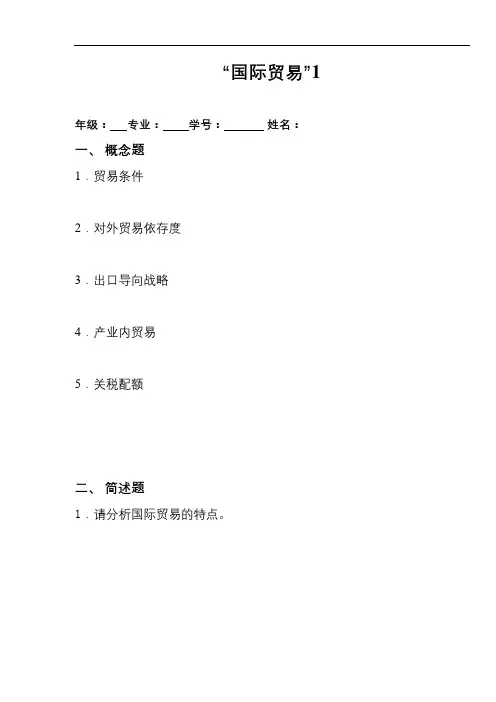
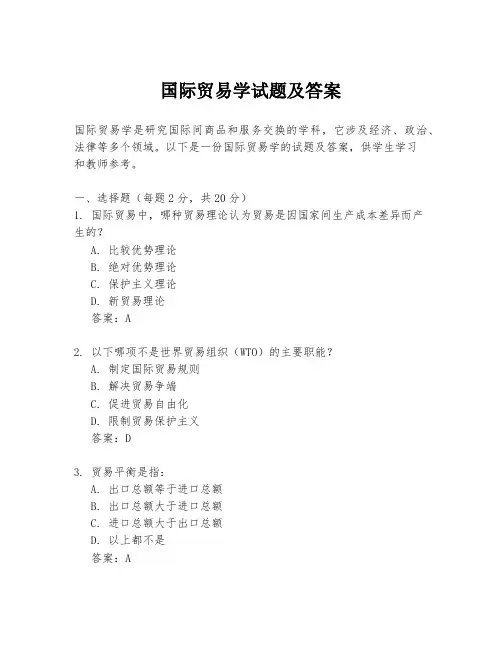
国际贸易学试题及答案国际贸易学是研究国际间商品和服务交换的学科,它涉及经济、政治、法律等多个领域。
以下是一份国际贸易学的试题及答案,供学生学习和教师参考。
一、选择题(每题2分,共20分)1. 国际贸易中,哪种贸易理论认为贸易是因国家间生产成本差异而产生的?A. 比较优势理论B. 绝对优势理论C. 保护主义理论D. 新贸易理论答案:A2. 以下哪项不是世界贸易组织(WTO)的主要职能?A. 制定国际贸易规则B. 解决贸易争端C. 促进贸易自由化D. 限制贸易保护主义答案:D3. 贸易平衡是指:A. 出口总额等于进口总额B. 出口总额大于进口总额C. 进口总额大于出口总额D. 以上都不是答案:A4. 以下哪个不是影响国际竞争力的因素?A. 技术创新B. 劳动力成本C. 政府干预D. 地理位置答案:D5. 什么是“最惠国待遇”?A. 给予所有贸易伙伴相同的关税待遇B. 只给予特定贸易伙伴优惠关税待遇C. 给予最亲近的贸易伙伴最低关税待遇D. 给予最亲近的贸易伙伴最高关税待遇答案:A二、简答题(每题10分,共30分)6. 简述比较优势理论的基本内容和意义。
答案:比较优势理论由大卫·李嘉图提出,其核心观点是即使一个国家在所有生产领域都不具有绝对优势,它仍然可以专注于生产自己相对效率最高的商品,通过贸易来获取其他商品,从而实现资源的最优配置和经济福利的最大化。
7. 描述保护主义政策对国际贸易的影响。
答案:保护主义政策通常包括关税壁垒、配额限制和补贴等措施,目的是保护国内产业免受外国竞争的影响。
然而,这些政策往往会导致贸易伙伴采取报复性措施,最终可能导致贸易战,损害全球经济的健康发展。
8. 解释什么是“多边贸易体系”以及它的重要性。
答案:多边贸易体系是指多个国家之间通过协议建立的贸易规则和机制,旨在促进贸易自由化和减少贸易壁垒。
它的重要性在于能够提供一个稳定的贸易环境,降低交易成本,促进全球经济一体化。
国际金融模拟题1一、简答题1、国际收支失衡对一国经济产生什么影响?国际收支失衡是指一国经常账户、金融与资本账户的余额出现问题,即对外经济出现了需要调整的情况。
一国国际收支失衡的经济影响:对外,国际收支失衡造成汇率、资源配置、福利提高的困难;对内,国际收支失衡造成经济增长与经济发展的困难,即对外的失衡影响到国内经济的均衡发展。
2、汇率为什么经常变动?在经济活动中有许多因素影响汇率变动:一、国际收支状况。
二、国民收入。
三、通货膨胀率的高低。
四、货币供给货币供给是决定货币价值、货币购买力的首要因素。
五、财政收支一国的财政收支状况对国际收支有很大影响。
六、利率七、各国汇率政策和对市场的干预八、投机活动与市场心理预期九、政治与突发因素。
在众多因素的作用下,汇率经常发生变动。
3、简述欧洲货币市场对世界经济的影响。
欧洲货币市场是指非居民间以银行为中介在某种货币发行国国境之外从事该种货币借贷的市场,又可以称为离岸金融市场。
欧洲货币市场的发展,起到了加速国际贸易的发展,促进国际金融的密切联系,促进了国际金融市场全球化,为逆差国提供了资金融通便利等积极作用。
但其同时也具有投机性和破坏性。
4、一国的国际储备越多越好吗?不是。
国际储备规模应该适度,如果国际储备国过多,就会造成资源的浪费,加大国内通货膨胀的压力,以及导致储备资产贬值的风险。
5、简述牙买加体系。
1、实行浮动汇率制度的改革。
2、推行黄金非货币化。
3、增强特别提款权的作用。
4、增加成员国基金份额。
5、扩大信贷额度,以增加对发展中国家的融资。
二、论述题固定汇率制度与浮动汇率制度孰优?固定汇率(fixed exchange rate)是在金本位制度下和布雷顿森林体系下通行的汇率制度,这种制度规定本国货币与其他国家货币之间维持一个固定比率,汇率波动只能限制在一定范围内,由官方干预来保证汇率的稳定。
浮动汇率(floating exchange rate)是指本国货币与其他国家货币之间的汇率不由官方制定,而由外汇市场供求关系决定,可自由浮动,官方在汇率出现过度波动时才干预市场,这是布雷顿森林体系解体后西方国家普遍实行的汇率制度。
大学国际贸易试题及答案### 大学国际贸易试题及答案#### 一、选择题1. 国际贸易中的“最惠国待遇”指的是:- A. 给予所有国家相同的贸易条件- B. 只给予特定国家贸易优惠- C. 给予所有国家最优惠的贸易条件- D. 只给予部分国家最优惠的贸易条件答案:A2. 以下哪项不是世界贸易组织(WTO)的主要职能?- A. 制定国际贸易规则- B. 解决成员国之间的贸易争端- C. 促进成员国之间的贸易自由化- D. 管理成员国的国内贸易政策答案:D3. 根据比较优势理论,一个国家应该专注于生产并出口: - A. 它生产成本最低的商品- B. 它生产成本最高的商品- C. 它生产效率最高的商品- D. 它生产效率最低的商品答案:C#### 二、简答题1. 简述什么是贸易壁垒,并列举至少两种常见的贸易壁垒。
答案:贸易壁垒是指国家或地区为了保护本国产业或市场,对外国商品和服务进入本国市场设置的各种限制措施。
常见的贸易壁垒包括关税壁垒和非关税壁垒。
关税壁垒是通过提高进口商品的关税来增加其成本,从而减少进口量;非关税壁垒则包括配额限制、进口许可证制度、技术标准和卫生标准等。
2. 描述绝对成本理论和比较成本理论的主要区别。
答案:绝对成本理论由亚当·斯密提出,主张一个国家应该生产并出口其绝对成本较低的商品,进口绝对成本较高的商品。
而比较成本理论由大卫·李嘉图提出,认为即使一个国家在所有商品的生产上都具有绝对成本优势,它也应该专注于生产并出口其相对成本最低的商品,进口相对成本较高的商品,因为这样可以实现资源的最优配置和国际分工。
#### 三、论述题1. 论述全球化对国际贸易的影响,并分析全球化背景下的贸易保护主义现象。
答案:全球化是指商品、服务、资本和劳动力在全球范围内的自由流动,它极大地促进了国际贸易的发展。
全球化使得生产要素可以在全球范围内进行最优配置,提高了生产效率,降低了成本,增加了商品和服务的多样性。
国际贸易(知识要点)1一、单选题(每题2分,共30分)1. 世贸组织处理发达成员方与发展中成员方之间贸易关系的一项基本原则是( ) 。
A、允许例外和保障措施原则B、互惠原则C、公平贸易原则D、发展中国家优惠待遇原则2. 从18世纪后半期到19世纪中叶是资本主义( )。
A、国际分工和世界市场的萌芽时期B、国际分工的形成和世界市场的建立时期C、国际分工体系和统一的世界市场的形成时期D、国际分工的升华和世界市场的扩大时期3. 从征税方法上讲,当代世界各国关税的主要形式是()。
A、从价税B、从量税C、混合税D、选择税4. 区域经济一体化中最低级、最松散的一种形式是( ) 。
A、优惠贸易安排B、自由贸易区C、关税同盟D、共同市场5. 一国拥有的劳动要素充裕,故它应专门生产劳动密集型产品对外进行交换。
这种说法来自()。
A、李嘉图的比较优势理论B、亚当•斯密的绝对优势理论C、赫克歇尔一俄林的要素禀赋理论D、维农的产品周期理论6. 不是古典国际贸易理论的分析方法有()。
A、产品无差异B、技术无差异C、规模收益不变D、完全竞争7. 具有内部规模经济的行业的典型特征是()。
A、行业的厂商数量多B、厂商规模一般不大C、厂商数量一般较少D、厂商规模一般很大8. 亚当·斯密的代表著作是()A、《政治经济学及赋税原理》B、《域际和国际贸易》C、《国民财富的性质和原因的研究》D、《国际贸易原理》9. 建立在规模经济基础上的国际贸易理论从()角度解释产业内贸易。
A、供给B、需求C、供求D、需求和供给10. 要素禀赋学说认为产生国际贸易的直接原因是()。
A、劳动生产率的国际差异B、商品价格的国际差异C、自然资源的国际差异D、需求的国际差异11. 与自由贸易区相比,关税同盟的经济一体化程度更高的标志是()。
A、实行商品的完全自由流动B、取消全部贸易壁垒C、实行对外统一关税D、取消全部关税壁垒12. 当一定时期内一国出口总额超过进口总额时,称为( )。
25个选择题共50分,两个简答题30分,两个计算题20分张老师说:选择题要理解为什么,否则不一定能够做对下面是第一章到第五章的选择题及答案余下答案:acadaccacbInterdependence: 互相依赖international:. 国际的microeconomic: 微观经济interregional:地区间的Choice questions1 Ricardo explained the law of comparative advantage on the basis of( A)A the labor theory of valueB the opportunity cost theoryC the law of diminishing returns:边际报酬递减定律D all of the above2. If with one hour of labor time nation A can produce either 3X or 3Y while nation B can produce either 1X or 3Y (and labor is the only input投入), the range of mutually 互相的beneficial trade between nation A and B is: (C )A. 3Y<3X<5YB. 5Y<3X<9YC. 3Y<3X<9YD. 1Y<3X<3Y3. The commodity商品in which the nation has the smallest absolute disadvantage is thecommodity of its (D ).A. absolute disadvantageB. absolute advantageC. comparative disadvantageD. comparative advantage4. If in a two-nation (A and B), two-commodity (X and Y) world, it is established that nation A has a comparative advantage in commodity X, then nation B must have: (D )A an absolute advantage in commodity YB an absolute disadvantage in commodity YC a comparative disadvantage in commodity YD a comparative advantage in commodity Y5. If domestically 国内的3X=3Y in nation A, while 1X=1Y domestically in nation B:(D )A there will be no trade between the two nationsB the relative price of X is the same in both nationsC the relative price of Y is the same in both nationsD all of the above6. An increase in the dollar price of a foreign currency 货币usually ( B)A benefits U.S. importers进口商B benefits U.S. Exporters 出口商C benefits both U.S. importers and U.S. exportersD harms both U.S. importers and U.S. exporters7. The Mercantilists 重商主义者did not advocate 提倡( A)A free tradeB stimulating the nation’s exports stimulate刺激C restricting 限制the nation’s importsD the accumulation积聚of gold by the nationSlope 倾斜stepwise 逐步地equilibrium relative commodity均衡相对商品intersection交叉点余下答案:BACDbd1. Which of the following statements is true with respect to the MRS of X for Y? ( D)A. It is given by the absolute slope斜率of the indifference curve 无差异曲线B. declines下降as the nation moves down an indifference curveC. rises as the nation moves up an indifference curveD. all of the above2 The marginal rate of transformation边际转换率(MRT)of X for Y refers to ( D)A the amount of Y that a nation must give up to produce each additional unit单位of XB the opportunity cost of XC the absolute slope of the production frontier生产可能性边界at the point of productionD all of the above3 The marginal rate of substitution边际替换率(MRS) of X for Y in consumption消费refers to the ( B)A amount of X that a nation must give up for one extra unit of Y and still remain on the same indifference curveB amount of Y that a nation must give up for one extra unit of X and still remain on the same indifference curveC amount of X that a nation must give up for one extra unit of Y to reach a higher indifference curveD amount of Y that a nation must give up for one extra unit of X to reach a higher indifference curve4. Which of the following is not a reason for increasing opportunity costs? ( A)A. technology differs among nationsB. factors of production are not homogenous同质的C. factors of production are not used in the same fixed proportion固定比例in the production of all commoditiesD. For the nation to produce more of a commodity, it must use resources that are less and less suited适合in the production of the commodity5. Export prices出口价格must rise for a nation to increase its exports because the nation: ( D)A incurs招致increasing opportunity costs in export productionB faces decreasing减少opportunity costs in producing import substitutes. 替代品C faces decreasing marginal rate of substitution in consumptionD all of the above6. In the trade between a small and a large nation (B ).A. the large nation is likely to receive all of the gains from tradeB. the small nation is likely to receive all of the gains from tradeC. the gains from trade are likely to equally sharedD. we cannot say7 Commodity indifference curves (D )A are negatively slopedB are convex凸的to the origin原点C should not cross交叉D all of the above8. Nation 1’s share份额of the gains from trade will be greater: (B )A. the greater is nation 1’s demand for nation 2’s exportsB. the closer Px/Py with trade settles贸易落定to nation 2’s pretrade Px/PyC. the weaker is nation 2’s demand for nation 1’s exportsD. the closer Px/Py with trade settles to nation 1’s pretrade Px/Pyconcave凹的intersect 相交application 应用equilibrium均衡compensation principle补偿原则isolation孤立inside在…之内tangent切线internal. 内部的exceed超过specialize专门化mutually互相地taste偏好余下答案:cdcacddddd1. If a nation does not affect world prices by its trading, its offer curve: ( a)A. is a straight lineB. bulges凸出toward the axis轴measuring衡量the import commodityC. intersects相交the straight-line直线segment部分of the world’s offer curveD. intersects the positively-sloped portion积极倾斜的部分of the world’s offer curve2. Which of the following statements regarding partial equilibrium analysis局部均衡分析is false? (c )A. it relies on traditional demand and supply curvesB. it isolates for study one marketC. it can be used to determine the equilibrium relative commodity price均衡相对商品价格but not the equilibrium quantity均衡产量with tradeD. it does not take into considerations the interactions相互作用between different markets3. If the nation’s tastes for its import commodity increases (d )A. the nation’s offer curve rotates旋转toward the axis measuring its import commodityB. the partner’s offer curve rotates toward the axis measuring its import commodityC. the partner’s offer curve rotates toward the axis measuring its export commodityD. the nation’s offer curve rotates toward the axis measuring its export commodity4. The offer curve of a nation bulges凸出toward the axis measuring the nation’s ( a)A. import commodityB. export commodityC. export or import commodityD. nontraded commodity5. The offer curve of a nation shows: (d )A. the supply of a nation’s importsB. the demand for a nation’s exportsC. the trade partner’s demand for imports and supply of exportsD. the nation’s demand for imports and supply of exports6. If the terms of trade贸易条件of a nation are 1.5 in a two-nation world, those of the trade partner are: ( b)A. 3/4B. 2/3C. 3/2D. 4/37. A deterioration恶化of a nation’s terms of trade causes the nation’s welfare to: (d )A. deteriorateB. improveC. remain unchangedD. any of the aboveapproximation近似sought寻找V olume量余下答案:dcdddaba1. Which is not an assumption假设of the H-O model? ( c)A. the same the technology in both nationsB. constant returns to scale规模报酬不变C. complete specialization完全专业化D. equal tastes相同偏好in both nations2. The Leontief paradox里昂惕夫悖论refers to the empirical finding实证发现that U.S.:(a )A. import substitutes are more K-intensive than exportsB. imports are more K-intensive than exportsC. exports are more L-intensive than importsD. exports are more K-intensive than import substitutes3. In the H-O model, international trade is based mostly on a difference in: (b )A. technologyB. factor endowments禀赋C. economies of scale规模经济D. tastes4. The H-O model extends延伸the classical trade model by: (c)A. explaining the basis for comparative advantageB. examining检查the effect of trade on factor pricesC. both A and BD. neither A nor B5. A difference in relative commodity prices between two nations can be based upon a difference in (d )A. factor endowmentsB. technologyC. tastesD. all of the above6. For factor reversal逆转to occur, two commodities must be produced with: (a )A. sufficiently充分地different elasticity of substitution替代弹性of factorsB. the same K/L ratio比率C. technologically-fixed factor proportions比例D. equal elasticity of substitution of factorsintensive集中的reject驳回,排斥await 等候余下答案:acbdcaddc简答题:每题最好都画图1.贸易理论:US和UK两国的W和C互换(见书),计算两国贸易所得2.画图说明一国两种产品的最优组合(无差异曲线与生产可能性曲线相交的切点)3.画图说明即使生产可能性曲线一样,无差异曲线不同,两国也能发生贸易4.求两国的提供曲线以及均衡贸易量和均衡产品价格5.Draw the offer curves for Nation 1 and Nation 2, showing that Nation 2 is a small nationthat trades at the pretrade-relative commodity prices in Nation 1. How are the gains fromtrade distributed between the two nations? Why?6.H—O—S模型,H—O模型7.里昂休斯悖论及解释6.幼稚产业观点7.说明产品周期8.Table 9——1 配额和关税的区别(因书上文字过多,就不一一写答案了)计算:1.题给两国的供给,需求曲线,求没有贸易时孤立均衡点2.给出供给,需求曲线的方程,计算关税,消费者损失,生产者剩余增加额(配额)3.第六章计算题第三题。